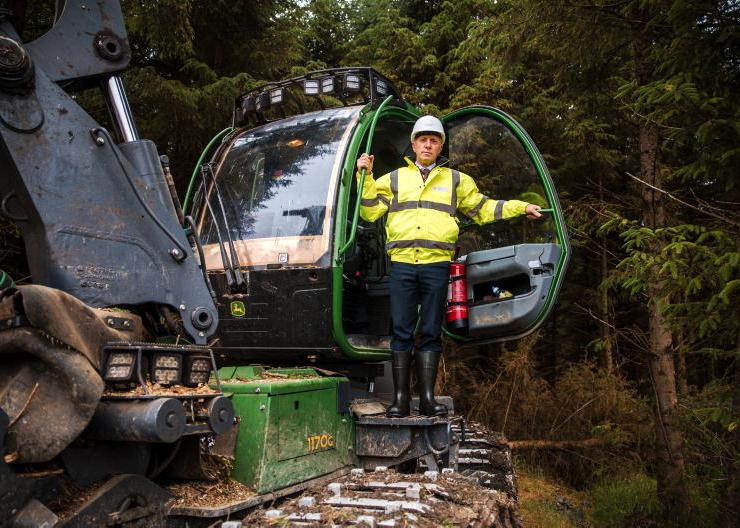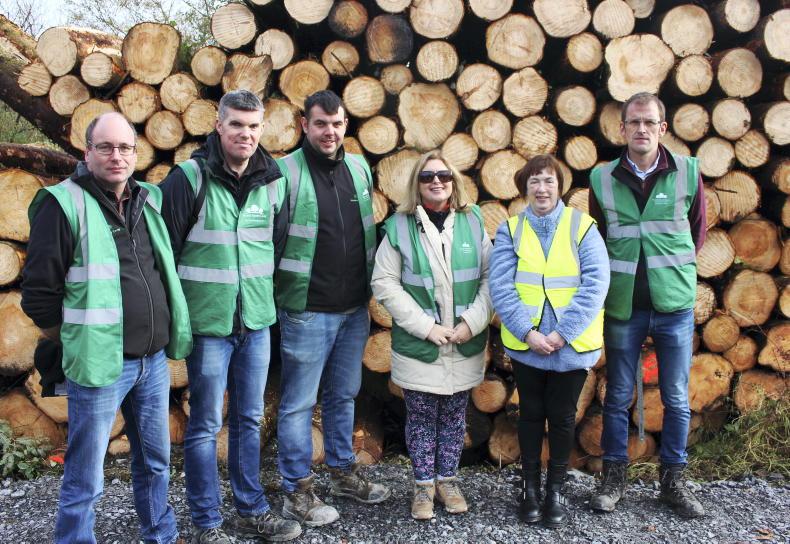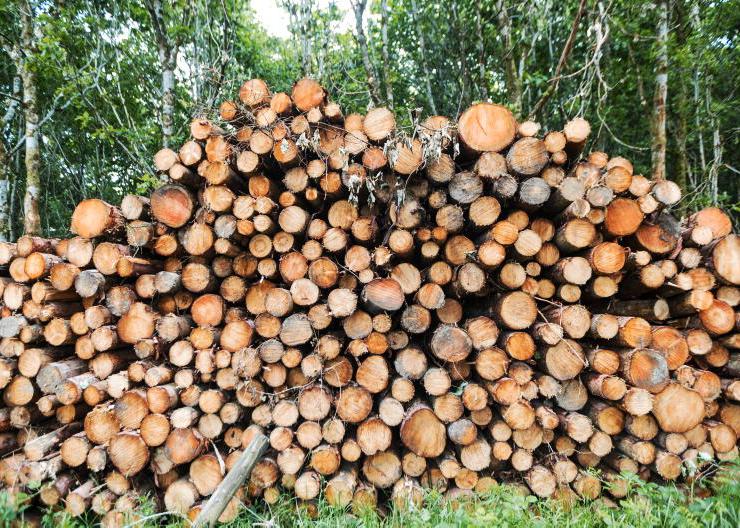Farmers will not be blown out of the land market by the controversial €200m forestry fund launched recently, Coillte and Gresham House have claimed.
Both Coillte and Gresham House insisted that purchases of bare land by its Irish Strategic Forestry Fund (ISFF) will average around 700ha for five years, or around 3,500ha in total. The prices paid will vary according to the site, they added.
The ISFF has already purchased 440ha (1,100ac) of standing forests near Newport in north Tipperary for €5.5m. This equates to €5,000/ac or €12,500/ha. The fund plans to purchase around 8,500ha of such forests in total.
“We will be extremely disciplined in acquiring sites and we will not overpay for any site,” insisted Joe O’Connell, investment director with Gresham House Ireland.
“We have seen inaccurate speculation that the ISFF might pay up to €9,000/ha – the reality is it cannot pay anything like this amount,” O’Connell said.
“The prices we pay for land will be far lower and the exact price will vary depending on the specifics of individual sites,” he maintained.
“The maximum price that we can pay will reflect the productivity of the land, access to the site, the degree to which the specific sites contribute to our environmental and social goals, and how close it is to our markets,” O’Connell explained.
Meanwhile, Coillte managing director Mark Carlin told the Irish Farmers Journal that he “acknowledged the sensitivities around land prices”.
However, he said it is not in Coillte’s interests to “drive up the price of land”.
The joint venture between Coillte and Gresham House – which aims to purchase 12,000ha of standing forests and bare land – has provoked strong opposition across the farming and private forestry sectors, and among opposition politicians.
Opponents are fearful that competition from the ISFF will push up land prices for ordinary farmers.
They have also questioned why State afforestation grants and premiums are being used to effectively finance the purchase of land by funds that are largely foreign-owned.
Some unease has also been expressed within Government regarding the Coillte-Gresham House tie-up.
While the Tánaiste Micheál Martin accepted that Ireland urgently needed to increase planting levels to meet its climate change targets, he said holding the land in State ownership should be considered.
“I think there is room to look at another model as well, where the State owns the land from the beginning,” the Tánaiste said.
A crunch meeting between Coillte and the Minister for Agriculture Charlie McConalogue and Minister for State Pippa Hackett takes place today (Thursday) to assess the implications of the Coillte-Gresham House joint venture. However, it is unclear what actions the Government can take at this point.
Coillte’s Mark Carlin maintained that the various Government departments had been informed on an ongoing basis during the development of its strategic vision to plant 100,000ha of native and commercial woodland by 2050.
Carlin insisted that no Coillte lands are being sold to the ISFF.
He said Coillte had been asked to get involved in afforestation in order to support efforts to achieve the national planting target of 8,000ha per year.
Coillte aims to plant 3,500ha of native and commercial forests each year to 2050 but Carlin claimed that this target was only achievable by drawing on third-party funds delivered by firms, such as Gresham House, because the level of capital investment required is in excess of €2bn.
Calls for McConalogue and Coillte to appear at committee
The Minister for Agriculture Charlie McConalogue and senior Coillte management have been asked to appear before the Oireachtas Agriculture Committee to discuss the Coillte-Gresham House joint venture.
Agriculture committee chair Jackie Cahill confirmed that invites had been issued to the parties offering dates in January and early February for such a hearing.
Deputy Cahill said that while investment funds managed by firms such as Gresham House cannot be precluded from purchasing Irish land, he claimed that Coillte’s actions in aiding this process raised “serious” concerns.
Rural interests
Similar reservations have been expressed by a broad coalition of rural forestry interests.
The organisations – which include the IFA, Irish Forestry Owners, SEEFA, Western Forestry Co-op, Forestry Owners Co-op Society and ACA – accused Coillte of acting as “an agent on behalf of foreign and national investment funds to transition 100,000ha of Irish farmland out of local farm ownership for afforestation by funds”.
“The recent announcement by Coillte that it has joined forces with a major foreign investment house to establish a fund to acquire 12,000ha of forests and bare land is strongly opposed by the majority of the main organisations in the agriculture and forest sector,” the organisations stated.
They claimed that up to €2.1bn of Irish taxpayers’ money could be paid in forestry grants and premiums to investment funds in Coillte’s drive to plant 100,000ha by 2050.
“We believe this is Government policy to meet afforestation targets at any cost.
“It is likely to be counterproductive.
“We do not support it. And it is a bad deal for Ireland,” the organisations maintained.
However, both Coillte and Gresham House maintained that the sale of timber would deliver the main income source from its afforestation investments and that farmers would be the primary beneficiaries of the new forestry programme.
“We see the vast majority of afforestation under the new programme being by farmers; and the money is there for them to do it,” said Joe O’Connell of Gresham House.
Sitka spruce – the Friesian of forestry
The planting of Sitka spruce in commercial forestry has been likened to the use of the Friesian cow in the dairy sector by Joe O’Connell of Gresham House.
“Sitka spruce is to forestry what the Friesian is to the dairy sector,” O’Connell maintained.
“It is often beaten up but the fact of the matter is that there are Sitka spruce-derived products in everybody’s house. It is in our floors, our walls, our roofs, our garden furniture,” he said.
The Gresham House investment director accepted that the new forests planted by the Irish Strategic Forestry Fund would be primarily conifers, but he said the woodlands would also include significant areas of broadleaves and space for biodiversity.
“For any new forests the most of the area that will be planted with conifers is 65%. The rest will be either areas of biodiversity enhancement or broadleaves,” O’Connell explained.
Farmers will not be blown out of the land market by the controversial €200m forestry fund launched recently, Coillte and Gresham House have claimed.
Both Coillte and Gresham House insisted that purchases of bare land by its Irish Strategic Forestry Fund (ISFF) will average around 700ha for five years, or around 3,500ha in total. The prices paid will vary according to the site, they added.
The ISFF has already purchased 440ha (1,100ac) of standing forests near Newport in north Tipperary for €5.5m. This equates to €5,000/ac or €12,500/ha. The fund plans to purchase around 8,500ha of such forests in total.
“We will be extremely disciplined in acquiring sites and we will not overpay for any site,” insisted Joe O’Connell, investment director with Gresham House Ireland.
“We have seen inaccurate speculation that the ISFF might pay up to €9,000/ha – the reality is it cannot pay anything like this amount,” O’Connell said.
“The prices we pay for land will be far lower and the exact price will vary depending on the specifics of individual sites,” he maintained.
“The maximum price that we can pay will reflect the productivity of the land, access to the site, the degree to which the specific sites contribute to our environmental and social goals, and how close it is to our markets,” O’Connell explained.
Meanwhile, Coillte managing director Mark Carlin told the Irish Farmers Journal that he “acknowledged the sensitivities around land prices”.
However, he said it is not in Coillte’s interests to “drive up the price of land”.
The joint venture between Coillte and Gresham House – which aims to purchase 12,000ha of standing forests and bare land – has provoked strong opposition across the farming and private forestry sectors, and among opposition politicians.
Opponents are fearful that competition from the ISFF will push up land prices for ordinary farmers.
They have also questioned why State afforestation grants and premiums are being used to effectively finance the purchase of land by funds that are largely foreign-owned.
Some unease has also been expressed within Government regarding the Coillte-Gresham House tie-up.
While the Tánaiste Micheál Martin accepted that Ireland urgently needed to increase planting levels to meet its climate change targets, he said holding the land in State ownership should be considered.
“I think there is room to look at another model as well, where the State owns the land from the beginning,” the Tánaiste said.
A crunch meeting between Coillte and the Minister for Agriculture Charlie McConalogue and Minister for State Pippa Hackett takes place today (Thursday) to assess the implications of the Coillte-Gresham House joint venture. However, it is unclear what actions the Government can take at this point.
Coillte’s Mark Carlin maintained that the various Government departments had been informed on an ongoing basis during the development of its strategic vision to plant 100,000ha of native and commercial woodland by 2050.
Carlin insisted that no Coillte lands are being sold to the ISFF.
He said Coillte had been asked to get involved in afforestation in order to support efforts to achieve the national planting target of 8,000ha per year.
Coillte aims to plant 3,500ha of native and commercial forests each year to 2050 but Carlin claimed that this target was only achievable by drawing on third-party funds delivered by firms, such as Gresham House, because the level of capital investment required is in excess of €2bn.
Calls for McConalogue and Coillte to appear at committee
The Minister for Agriculture Charlie McConalogue and senior Coillte management have been asked to appear before the Oireachtas Agriculture Committee to discuss the Coillte-Gresham House joint venture.
Agriculture committee chair Jackie Cahill confirmed that invites had been issued to the parties offering dates in January and early February for such a hearing.
Deputy Cahill said that while investment funds managed by firms such as Gresham House cannot be precluded from purchasing Irish land, he claimed that Coillte’s actions in aiding this process raised “serious” concerns.
Rural interests
Similar reservations have been expressed by a broad coalition of rural forestry interests.
The organisations – which include the IFA, Irish Forestry Owners, SEEFA, Western Forestry Co-op, Forestry Owners Co-op Society and ACA – accused Coillte of acting as “an agent on behalf of foreign and national investment funds to transition 100,000ha of Irish farmland out of local farm ownership for afforestation by funds”.
“The recent announcement by Coillte that it has joined forces with a major foreign investment house to establish a fund to acquire 12,000ha of forests and bare land is strongly opposed by the majority of the main organisations in the agriculture and forest sector,” the organisations stated.
They claimed that up to €2.1bn of Irish taxpayers’ money could be paid in forestry grants and premiums to investment funds in Coillte’s drive to plant 100,000ha by 2050.
“We believe this is Government policy to meet afforestation targets at any cost.
“It is likely to be counterproductive.
“We do not support it. And it is a bad deal for Ireland,” the organisations maintained.
However, both Coillte and Gresham House maintained that the sale of timber would deliver the main income source from its afforestation investments and that farmers would be the primary beneficiaries of the new forestry programme.
“We see the vast majority of afforestation under the new programme being by farmers; and the money is there for them to do it,” said Joe O’Connell of Gresham House.
Sitka spruce – the Friesian of forestry
The planting of Sitka spruce in commercial forestry has been likened to the use of the Friesian cow in the dairy sector by Joe O’Connell of Gresham House.
“Sitka spruce is to forestry what the Friesian is to the dairy sector,” O’Connell maintained.
“It is often beaten up but the fact of the matter is that there are Sitka spruce-derived products in everybody’s house. It is in our floors, our walls, our roofs, our garden furniture,” he said.
The Gresham House investment director accepted that the new forests planted by the Irish Strategic Forestry Fund would be primarily conifers, but he said the woodlands would also include significant areas of broadleaves and space for biodiversity.
“For any new forests the most of the area that will be planted with conifers is 65%. The rest will be either areas of biodiversity enhancement or broadleaves,” O’Connell explained.










SHARING OPTIONS